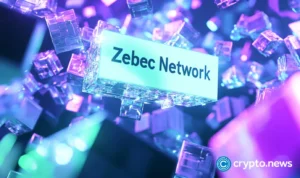Bitcoin is evolving beyond its status as “digital gold”, with the emergence of Layer-2 networks providing the foundation for a new generation of decentralized finance applications.
Until recently, developers struggled to build on Bitcoin due to its limited programmability and a lack of proper tooling, but the emergence of new Layer-2 networks has altered that dynamic. These days, Bitcoin is rapidly expanding and becoming more sophisticated and versatile, growing the prospects for a new financial economy that lives in parallel to the existing one based on fiat.
This is precisely the goal of Maestro, a blockchain infrastructure startup originally focused on Cardano. It has since pivoted to Bitcoin, where it’s playing a pivotal role in the growth of new Bitcoin-based DeFi applications such as DEX platforms, lending protocols, NFTs, and more.
“Our platform lowers the barrier to entry so developers can come to these Bitcoin L2s and very quickly reduce the time to market to half of what it was without an infrastructure provider,” Maestor co-founder and Chief Executive Marvin Bertin said in a recent podcast. “We’re building all of these tools (for Bitcoin L2 development) to help developers become the catalyst for Bitcoin ecosystem growth.”
The Renaissance of Bitcoin
Bertin was speaking to The Edge of Show at the recent Inscribing Vegas event, on the sidelines of the Bitcoin 2025 Conference in Las Vegas earlier this month. There, he discussed some of the latest innovations in areas such as Ordinals and Runes and how these developments are driving rampant growth in the Bitcoin ecosystem.
“Bitcoin is going through a renaissance, where its ecosystem has grown more in the past two years than it has in the last five or 10 years,” Bertin said
According to Bertin, Maestro was compelled to attend Inscribing Vegas because it’s a part of the biggest Bitcoin event of the year, and he feels that this year’s event is going to be even more special than previous editions were, thanks to the incredible pace of innovation within its ecosystem.
Bitcoin has long been seen as the cornerstone of the crypto industry due to its immense value, with its $2.35 trillion market capitalization outweighing all other cryptocurrencies combined. Heralded as a “digital gold”, it is by far the industry’s most sought-after asset, primarily because it’s seen as a store of value and a hedge against inflation.
But that view is changing as Bitcoin has evolved with the rise of new concepts such as L2s, Ordinals, and Runes, which demonstrate its potential to be more than just a store of value and a payment mechanism. Ordinals is a protocol that enables unique digital artefacts to be inscribed onto individual satoshis and stored on the Bitcoin blockchain, while L2s enrich Bitcoin with smart contract capabilities.
“We’re entering a new chapter for Bitcoin, and there’s really a whole new energy about it,” Bertin said. “The introduction of Ordinals and Runes changed people’s minds about what we can do with Bitcoin, and what it means to use Bitcoin.”
Among those who are considering new utility for Bitcoin are some of the world’s biggest financial players. Bertin cited the increasing adoption of crypto among financial institutions, such as hedge funds and banks, as well as large corporations and even nation states such as El Salvador, which has legalized Bitcoin.
At the same time, the U.S. government is embracing digital assets in a really big way, with new pro-crypto laws and regulations being introduced under the Donald Trump administration. With so many organizations holding Bitcoin on their balance sheets and in their treasuries, there’s a lot of interest in putting those funds to work, in much the same way as fiat-based assets are invested.
“These people want new tools and services,” Bertin explained, pointing out that they rarely just sit on their traditional financial assets. “They’re asking, how can I earn yield on my Bitcoin, how can I use it to raise funds, or take out a loan?”
Building A New Financial World
It’s precisely this demand that’s responsible for the wave of Bitcoin-based dApps and services that live on Layer-2 networks. They include DEX platforms, lending protocols, and so on, which enable investors to leverage BTC natively, without using custodians and blockchain bridges.
“You have this explosion of creativity, with entrepreneurs who are thinking that they’ve got something new that they can build with all of these new primitives,” Bertin said. “We’re entering a new market shift, and we’re going to see a lot of new products that can hopefully onboard people who haven’t touched blockchain before, but now find that the user experience of the benefits means it’s a really good time to get into this industry.”
🚨Our latest episode is live!
What does creativity look like on-chain?
We sat down with @POSTWOOK, @MarvinDefi, @uniqueNFT, @Ape1926, and @SteveMiller_PHX to explore how Bitcoin is powering the next wave of art, culture, and innovation 🎙️
Stream now 👇 pic.twitter.com/IumhXlKDmL
— The Edge of Show 🎙 (@TheEdgeofShow) July 23, 2025
While Maestro’s infrastructure is primarily geared towards dApp developers, the company finds itself in an advantageous position, as that skillset means it’s perfectly situated to cater to institutional clients and their needs, too. Given the rapid evolution of Bitcoin’s ecosystem, there are very few others who are positioned to give them that kind of assistance. It’s this exciting new world that Maestro wants to support with its extensive infrastructure platform, and it has already made a lot of progress in a very short space of time, expanding just as rapidly as the Bitcoin ecosystem is doing. According to Bertin, he’s seeing a lot of interest from asset managers and institutions that need help to create customized financial solutions and products that can be optimized for their specific risk factors and operational requirements.
“We have the expertise and we think we can build some very powerful new Bitcoin financial rails, or the backbone for a new set of products where real-world TradFi money can leverage Bitcoin to create a parallel financial system,” Bertin said.
Read the full article here









